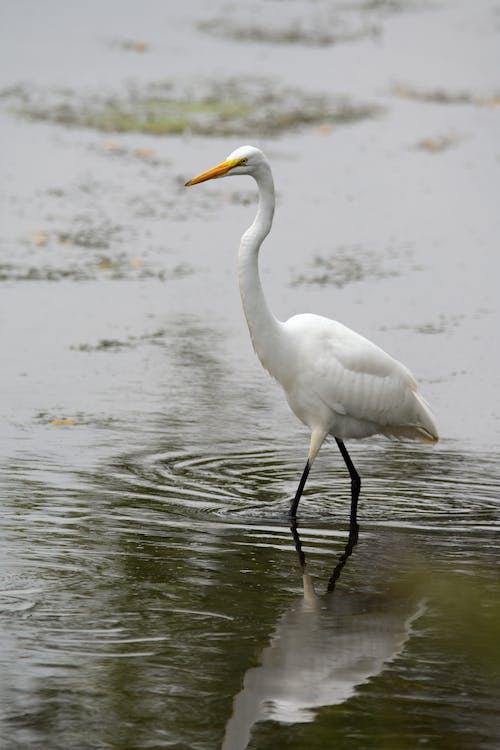The Great White Egret, also known as Great Egret, Common Egret, Large Egret, Great White Heron, and Ardea alba, is a widely distributed egret species across Africa, Asia, America, and southern Europe. This bird resides in the tropical and warmer temperate areas of the world. The Great White Egret is a member of the Ardeidae or heron family, making it a close relative of pelicans.
The Great White Egret was the chosen symbol of the National Audubon Society, a community formed in 19 53 to prevent the killing of birds for their feathers. During the 19th century, Great White Egrets were hunted by plume hunters to use their striking plumage for clothes, which led to a dramatic decline in its population. But today, the birds are enjoying legal protection, which led to an increase in their numbers worldwide.
This bird species was first described by Carl Linnaeus, also known as the father of modern taxonomy, in 1758.
Unlike other egret species, the Great White Egret is not a member of the genus Egretta, but it belongs with the great herons of the genus Ardea. Four subspecies of the Great White Egret are sighted in many parts of the world. These subspecies have minimal differences, particularly its size and coloration. Its four subspecies are the following:
- a. alba – found across Europe and Palearctic
- a. egretta – found across America
- a. melanorhynchos – located in Africa
- a. modesta – Also known as the Easter Great Egret, it is found across Southeast Asia, India, and Oceania
Since the Great White Egret and its subspecies are widely distributed across the world, and their population is on a stable rise, the International Union for Conservation of Nature (IUCN) Red List categorized the bird species as Least Concern.
Its seven levels of scientific classification are as follows:
Kingdom: Animalia
Phylum: Chordata
Class: Aves
Order: Pelecaniformes
Family: Ardeidae
Genus: Ardea
Species: A. alba
The physical characteristics of a Great White Egret
The Great White Egret is usually the largest white egret that occurs anywhere in its range. And it is not hard to identify a Great White Egret—it is almost as large as a Grey Heron, but with all-white plumage, longer neck, and longer legs. It stands up to 3.3 ft tall, measures from 80 to 104 cm, and has a wingspan of 131 to 170 cm. An adult Great White Egret weighs between 1.5 to 3.3 lb. Apart from its gigantic size, the Great White Egret can be distinguished from other white egrets by its black legs, black feet, and yellow bill, although legs and feet may become lighter and the bill becomes darker during the breeding season.
Male and female Great White Egrets share the same physical characteristics. They have a slow flight, with necks retracted. This particular in-flight attribute distinguishes herons and bitterns from cranes, storks, spoonbills, and ibises, which extend their necks in flight.
The distribution and habitat of Great White Egrets
These birds appear in almost any part of the United Kingdom, other parts of southern Europe, central and south Africa, north and south America, southern Canada, Southeast Asia, Oceania, and India.
Great White Egrets are semi-migratory, with northern hemisphere birds flying south from regions with colder winters. They frequent habitats like freshwaters, extensive wetlands, and reedbeds.
The behavior of Great White Egrets
During the breeding season, Great White Egrets breed in colonies in trees close to extensive lakes. They start breeding when they reach 2-3 years of age. These birds form monogamous pairs each season, with the male selecting the nest area, building the nest, then attracting a female bird. The female Great White Egret will lay 3-6 bluish eggs, which will be incubated by both parents. The young egrets are fed by parents through regurgitation by both parents and can fly within 6-7 weeks of age. The young are aggressive towards each other in the nest. Sometimes, the stronger ones often kill their weaker siblings.
The diet and eating habits of a Great White Egret
This species feeds on freshwater, saltwater, wetlands, tidal flats, ponds, streams, and other wet areas. When hunting for prey, it strolls or stands still for long periods, waiting for prey to present itself. One an opportunity shows up, the Great White Egret quickly thrusts its sharp bill and swallows the prey whole. Its diet mainly consists of amphibians, fish, mice, reptiles, and other small animals.
BOTSWANA BIRDS | SOUTH AFRICA BIRDS
NAMIBIA BIRDS | ZAMBIA BIRDS | ZIMBABWE BIRDS

